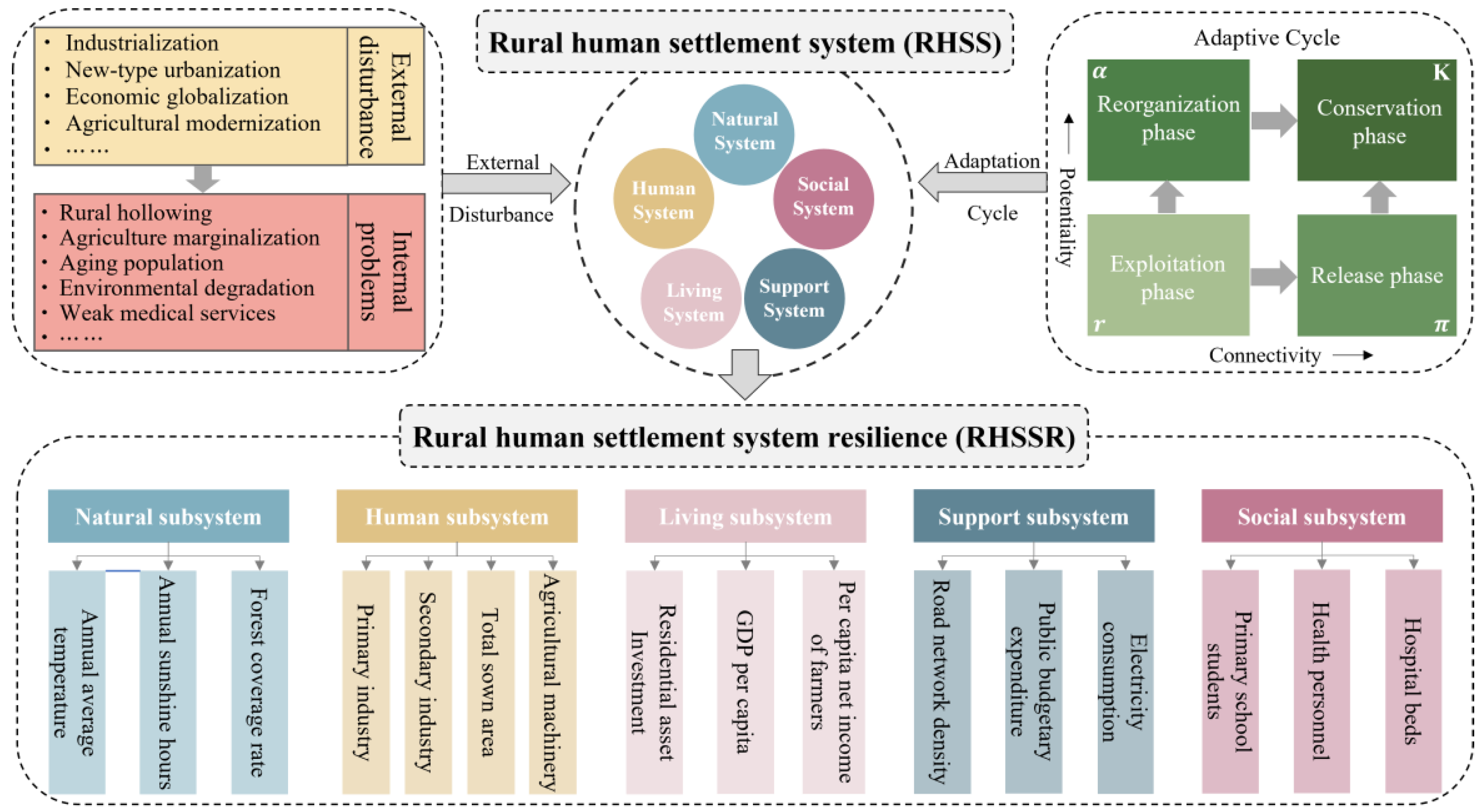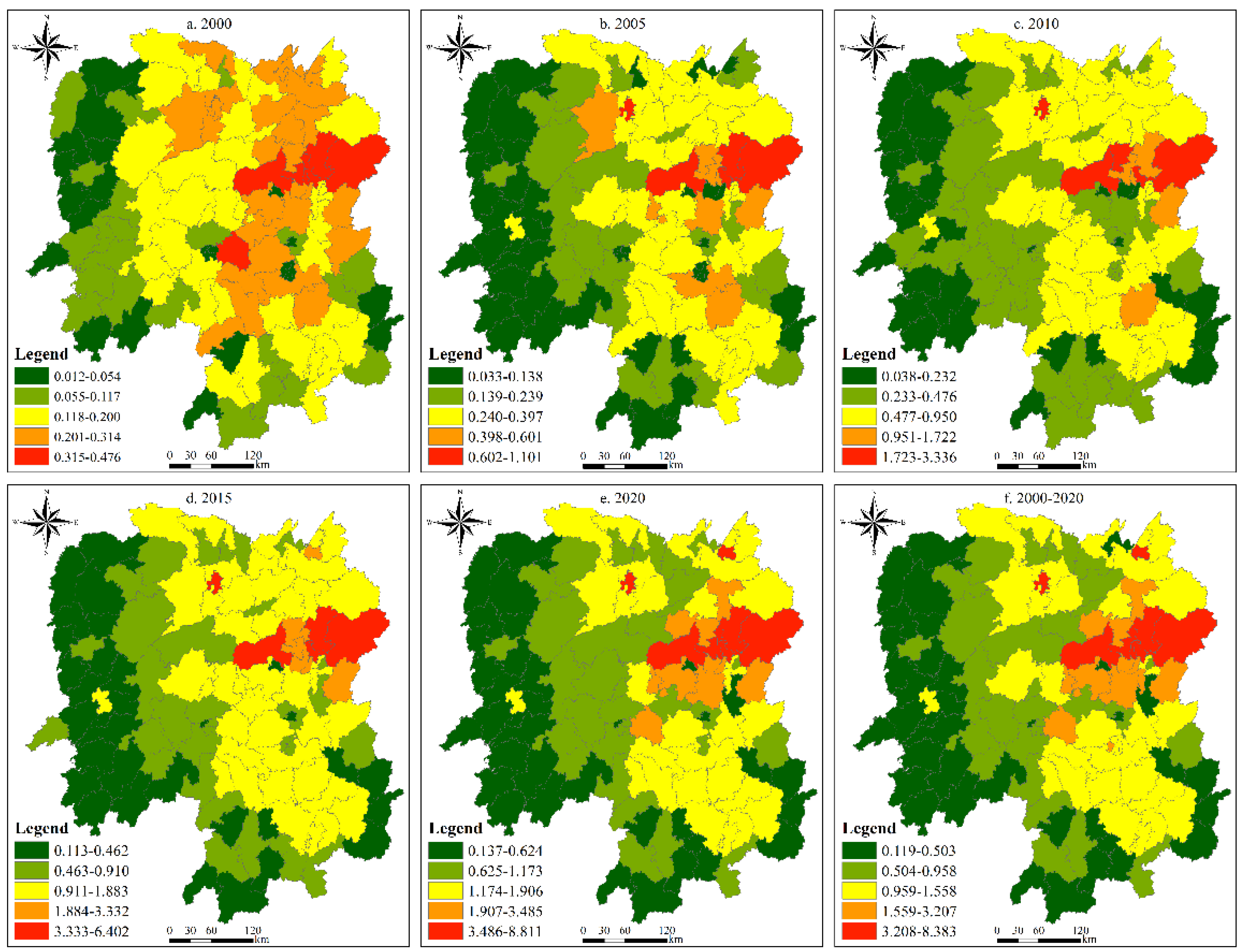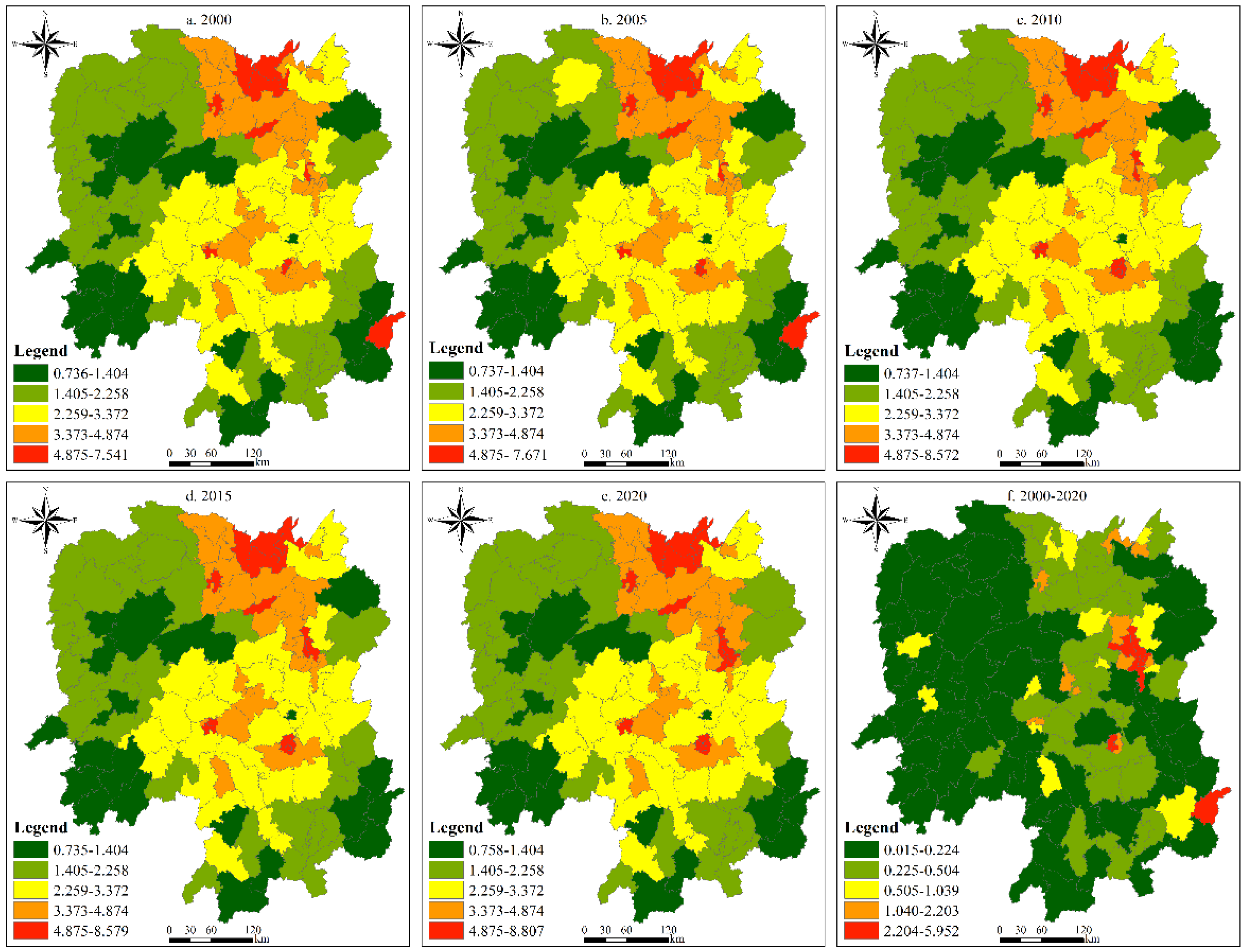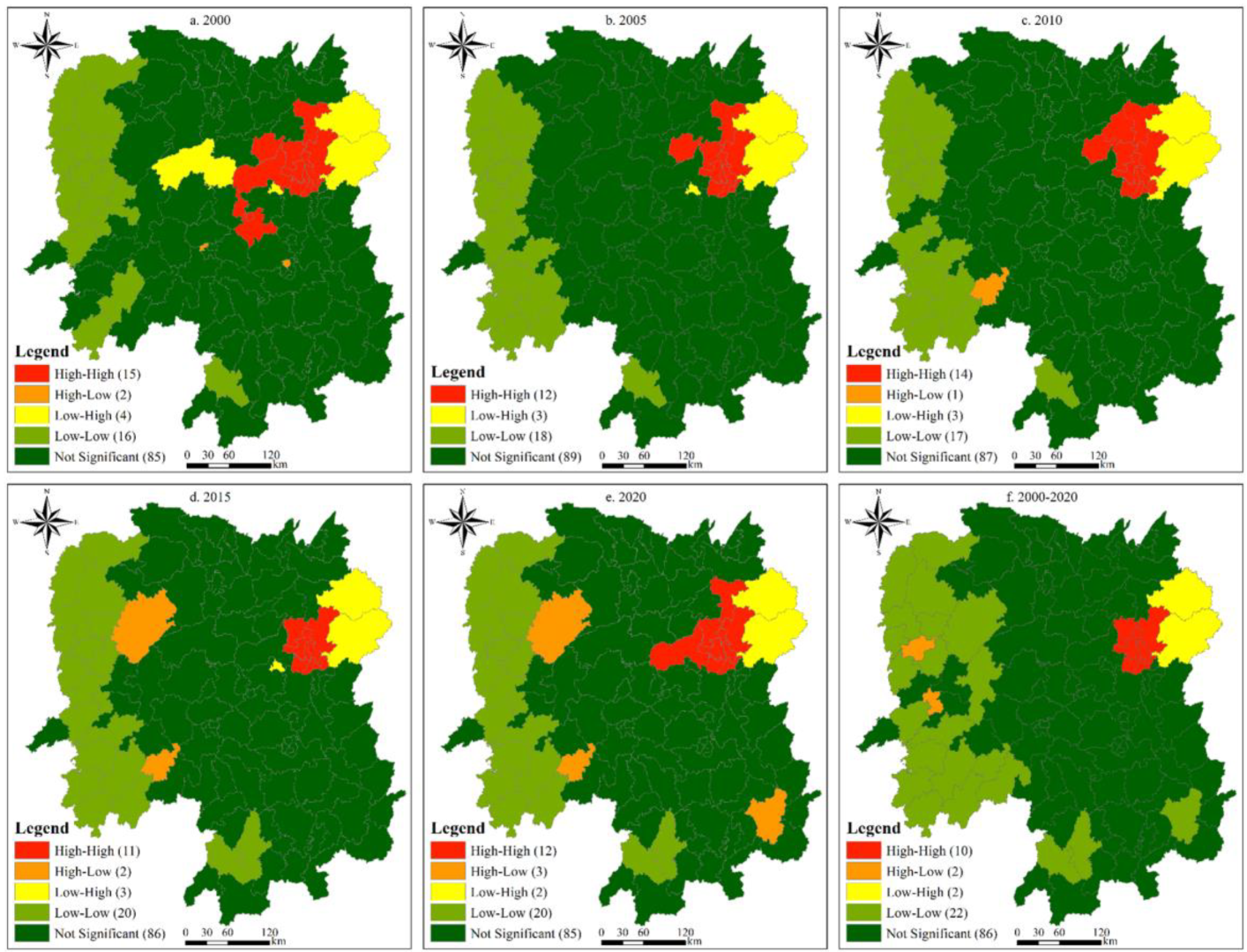The Spatial Association of Rural Human Settlement System Resilience with Land Use in Hunan Province, China, 2000–2020
Abstract
:1. Introduction
2. Materials and Methods
2.1. Data Sources
2.2. Methods
2.2.1. Quantifying RHSSR
2.2.2. Quantifying LUCC
2.2.3. Spatial Autocorrelation Analysis
2.2.4. The Geodetector Model
3. Results
3.1. Spatiotemporal Distribution Patterns of RHSSR
3.2. Analysis of LUCC in Hunan Province from 2000 to 2020
3.2.1. Analysis of Landscape Type Changes
3.2.2. Spatiotemporal Distribution Patterns of LUI
3.3. Spatial Association of RHSSR with LUI
3.4. The Driving Forces of RHSSR
4. Discussion
5. Conclusions
- (1)
- The area of built-up land in Hunan Province increased annually, and the area of built-up land has expanded by 3.4 times in the past 20 years, while the rural residential areas showed a fluctuating trend of first increasing, then decreasing, and then increasing. This shows that rapid urbanization has caused major changes in the pattern of urban and rural residential areas. At the same time, the RHSSR level increased, with the average value increasing from 0.158 to 1.406, indicating that human activities have changed various elements of the human settlement system, resulting in a more pleasant natural environment, better infrastructure, more convenient public services, a more harmonious cultural environment, and more habitable housing conditions.
- (2)
- From 2000 to 2020, the resilience level of the rural human settlement in Hunan Province generally presented a three-level stepped spatial distribution feature of “high in the east and low in the west, with a belt-like distribution”. The RHSSR was highly consistent with LUI, with both having the characteristics of “low value areas are distributed in high value areas” and “high value areas are distributed in low value areas”. During 2000–2020, there was significant spatial heterogeneity in the spatial relationship between LUI and RHSSR, with high–high and low–low agglomerations being particularly prominent.
- (3)
- The evolution of RHSSR is the result of factors such as industrial development, improvements in medical services, increased income, and environmental protection. As a pillar of early rural economic development, the role of influencing factors such as the sown area, total agricultural machinery power, value added of primary industry, and primary school students on RHSSR gradually diminished with the transformation of agriculture, establishment of road construction projects, and human settlement improvements. Interactions between improved health services, population income, industrial development, and other factors can enhance the impact of RHSSR evolution.
Author Contributions
Funding
Data Availability Statement
Acknowledgments
Conflicts of Interest
References
- Argent, N. Rural geography II: Scalar and social constructionist perspectives on climate change adaptation and rural resilience. Prog. Hum. Geogr. 2019, 43, 183–191. [Google Scholar] [CrossRef]
- Li, Y. A systematic review of rural resilience. China Agric. Econ. Rev. 2023, 15, 66–77. [Google Scholar] [CrossRef]
- Zhao, X.; Xiang, H.; Zhao, F. Measurement and Spatial Differentiation of Farmers’ Livelihood Resilience Under the COVID-19 Epidemic Outbreak in Rural China. Soc. Indic. Res. 2023, 166, 239–267. [Google Scholar] [CrossRef] [PubMed]
- Holling, C.S. Resilience and Stability of Ecological Systems. Annu. Rev. Ecol. Evol. Syst. 1973, 4, 1–23. [Google Scholar] [CrossRef] [Green Version]
- Bristow, G. Resilient Regions: Re-‘place’ing Regional Competitiveness. Camb. J. Reg. Econ. Soc. 2009, 3, 153–167. [Google Scholar] [CrossRef]
- Yang, Y. Research hotspots and evolution trends of rural resilience in the perspective of biodiversity—Based on citespace’s visual analysis of bibliometrics. Front. Environ. Sci. 2022, 10, 1029510. [Google Scholar] [CrossRef]
- Li, Y.; Song, C.; Huang, H. Rural Resilience in China and Key Restriction Factor Detection. Sustainability 2021, 13, 1080. [Google Scholar] [CrossRef]
- Gallopín, G.C. Linkages between vulnerability, resilience, and adaptive capacity. Glob. Environ. Chang. 2006, 16, 293–303. [Google Scholar] [CrossRef]
- Heijman, W.; Hagelaar, G.; van der Heide, M. Rural resilience as a new development concept. In EU Bioeconomy Economics and Policies; Dries, L., Heijman, W., Jongeneel, R., Purnhagen, K., Wesseler, J., Eds.; Springer International Publishing: Cham, Switzerland, 2019; Volume II, pp. 195–211. [Google Scholar] [CrossRef]
- Ge, D.; Zheng, Y.; Zhang, S.; Fu, J.; Su, F. Spatio-temporal pattern and influence mechanism of rural human settlements system resilience: Case from China. Sustainability 2022, 14, 14533. [Google Scholar] [CrossRef]
- Huang, X.; Li, H.; Zhang, X.; Zhang, X. Land use policy as an instrument of rural resilience-the case of land withdrawal mechanism for rural homesteads in China. Ecol. Indic. 2018, 87, 47–55. [Google Scholar] [CrossRef]
- Olsson, L.; Jerneck, A.; Thorén, H.; Persson, J.; O’Byrne, D. Why resilience is unappealing to social science: Theoretical and empirical investigations of the scientific use of resilience. Sci. Adv. 2015, 1, 1400217. [Google Scholar] [CrossRef] [PubMed] [Green Version]
- Wang, C.; Dai, R.; Chen, J.; Shen, Y.; Ji, M. Research on the evolution law and promotion pathway of rural human settlements system resilience: A case study of Western Chongqing, a national pilot area for urban-rural integration. J. Nat. Resour. 2022, 37, 645–661. [Google Scholar] [CrossRef]
- Howard, E. Garden Cities of Tomorrow; S. Sonnenschein & Co., Ltd.: London, UK, 1902. [Google Scholar]
- Doxiadis, K. Ekistics: An Introduction to the Science of Human Settlements; Oxford University Press: Oxford, UK, 1968; Volume 60, p. 147. [Google Scholar]
- Greber, K.; Shelton, G. Assessment of neighborhood satisfaction by residents of three housing types. Soc. Indic. Res. 1987, 19, 303–315. [Google Scholar] [CrossRef]
- Li, Y.; Zhang, X.; Chen, Y. The impact of human settlement quality on rural development: A quantitative analysis based on the cross-sectional data of sampled villages in Jiangsu province. China Popul. Res. Environ. 2020, 30, 158–167. (In Chinese) [Google Scholar]
- Tang, L.; Long, H.; Ge, D. Spatial differentiation characteristics and mechanism of rural human settlement resilience formation: A case study of Dongting Lake area. Acta Geogr. Sin. 2023, 78, 1339–1354. (In Chinese) [Google Scholar]
- Qu, Y.; Dong, X.; Ping, Z.; Guan, M. Quality evaluation and improvement strategies of rural residential areas utilization from the perspective of human and land coordination. Trans. Chin. Soc. Agric. Eng. 2021, 37, 252–262. (In Chinese) [Google Scholar]
- Zhu, Y.; Zhou, X.; Luo, J. Spatio-temporal evaluation of rural human settlements quality and its differentiations in urban agglomeration in the middle reaches of the Yangtze River. Econ. Geogr. 2021, 41, 127–136. (In Chinese) [Google Scholar]
- Lin, S.; Hou, L. SDGs-oriented evaluation of the sustainability of rural human settlement environment in Zhejiang, China. Heliyon 2023, 9, e13492. [Google Scholar] [CrossRef]
- Ciolac, R.; Adamov, T.; Iancu, T.; Popescu, G.; Lile, R.; Rujescu, C.; Marin, D. Agritourism—A Sustainable Development Factor for Improving the ‘Health’ of Rural Settlements. Case Study Apuseni Mountains Area. Sustainability 2019, 11, 1467. [Google Scholar] [CrossRef] [Green Version]
- Qu, Y.; Zhan, L.; Jiang, G.; Ma, W.; Dong, X. How to Address “Population Decline and Land Expansion (PDLE)” of rural residential areas in the process of Urbanization: A comparative regional analysis of human-land interaction in Shandong Province. Habitat Int. 2021, 117, 102441. [Google Scholar] [CrossRef]
- Amit-Cohen, I.; Sofer, M. Integrated rural heritage landscapes: The case of agricultural cooperative settlements and open space in Israel. J. Rural. Stud. 2017, 54, 98–110. [Google Scholar] [CrossRef]
- Yang, J.; Gao, Y.; Yang, X. Study on the integration of vulnerability and resilience of rural human settlements system based on Grounded theory: Evolutionary characteristics, paths and theoretical model. Geogr. Res. 2023, 42, 209–227. (In Chinese) [Google Scholar]
- Ma, R.; Wang, T.; Zhang, W.; Yu, J.; Wang, D.; Chen, L.; Jiang, Y.; Feng, G. Overview and progress of Chinese geographical human settlement research. J. Geogr. Sci. 2016, 26, 1159–1175. [Google Scholar] [CrossRef]
- Wang, Y.; Zhu, Y. Exploring the effects of rural human settlement on rural development: Evidence from Xianju County in Zhejiang Province, China. Environ. Dev. 2023, 46, 100845. [Google Scholar] [CrossRef]
- Zhang, R.; Zhang, X. Spatial Pattern Evolution and Driving Mechanism of Rural Settlements in Rapidly Urbanized Areas: A Case Study of Jiangning District in Nanjing City, China. Land 2023, 12, 749. [Google Scholar] [CrossRef]
- Tian, Y.; Jiang, G.; Zhou, D.; Zhou, T.; Ma, W. A Refined Rural Settlements Simulation Considering the Competition Relationship among the Internal Land Use Types: A Case Study of Pinggu District. Land 2022, 11, 661. [Google Scholar] [CrossRef]
- Long, H. Land Use Transitions and Rural Restructuring in China; Springer: Singapore, 2020. [Google Scholar]
- Liu, Y.; Li, Y. Revitalize the world’s countryside. Nature 2017, 548, 275–277. [Google Scholar] [CrossRef] [Green Version]
- Tang, H.; Wu, Y.; Chen, J.; Deng, L.; Zeng, M. How Does Change in Rural Residential Land Affect Cultivated Land Use Efficiency? An Empirical Study Based on 42 Cities in the Middle Reaches of the Yangtze River. Land 2022, 11, 2263. [Google Scholar] [CrossRef]
- Chen, W.; Zhou, T.; Liang, J. Urbanization, ecosystem services, and their interactive coercive relationship in Hunan Province, China. Environ. Sci. Pollut. Res. 2023, 30, 3416–3431. [Google Scholar] [CrossRef]
- Xu, X.; Liu, J.; Zhang, S.; Li, R.; Yan, C.; Wu, S. China Multi-Period Land Use Remote Sensing Monitoring Dataset (CNLUCC). Resource and Environmental Science Data Registration and Publishing System. 2018. Available online: http://www.resdc.cn/DOI (accessed on 3 May 2023).
- Liu, J.; Zhang, Z.; Xu, X.; Kuang, W.; Zhou, W.; Zhang, S.; Li, R.; Yan, C.; Yu, D.; Wu, S.; et al. Spatial patterns and driving forces of land use change in China during the early 21st century. J. Geogr. Sci. 2010, 20, 483–494. [Google Scholar] [CrossRef]
- Tang, L.; Ruth, M.; He, Q.; Mirzaee, S. Comprehensive evaluation of trends in human settlements quality changes and spatial differentiation characteristics of 35 Chinese major cities. Habitat Int. 2017, 70, 81–90. [Google Scholar] [CrossRef]
- Sun, X.; Zhou, Z.; Chen, Q. Study on the Coupling and Coordination Development of Population-economic-ecological Environment in Key Ecological Function Areas: A Case of Yanhe County of Guizhou. J. Chongqing Norm. Univ. (Nat. Sci. Ed.) 2017, 34, 127–134. (In Chinese) [Google Scholar]
- Huang, J.; Zhang, X. Research on Enterprise Patents Quality Evaluation Based on Objective Combination Weighting Model: Taking the Knowledge-intensive Enterprises in Wuzhong District of Suzhou City as an Example. Sci. Technol. Manag. Res. 2020, 40, 133–141. (In Chinese) [Google Scholar]
- Pan, N.; Guan, Q.; Wang, Q.; Sun, Y.; Li, H.; Ma, Y. Spatial Differentiation and Driving Mechanisms in Ecosystem Service Value of Arid Region: A case study in the middle and lower reaches of Shule River Basin, NW China. J. Clean. Prod. 2021, 319, 128718. [Google Scholar] [CrossRef]
- Chen, W.; Chi, G.; Li, J. The spatial association of ecosystem services with land use and land cover change at the county level in China, 1995–2015. Sci. Total Environ. 2019, 669, 459–470. [Google Scholar] [CrossRef]
- Chen, W.; Zeng, J.; Li, N. Change in land-use structure due to urbanisation in China. J. Clean. Prod. 2021, 321, 128986. [Google Scholar] [CrossRef]
- Li, D.; Wang, X. Land-Use Change and Efficiency in Laos’ Special Economic Zones. Land 2021, 10, 1012. [Google Scholar] [CrossRef]
- Zheng, Y.; Cheng, L.; Wang, Y. Measuring the Spatial Conflict of Resource-Based Cities and Its Coupling Coordination Relationship with Land Use. Land 2022, 11, 1460. [Google Scholar] [CrossRef]
- Xu, F.; Chi, G. Spatiotemporal variations of land use intensity and its driving forces in China, 2000–2010. Reg. Environ. Chang. 2019, 19, 2583–2596. [Google Scholar] [CrossRef]
- Felipe-Lucia, M.R.; Soliveres, S.; Penone, C.; Fischer, M.; Ammer, C.; Boch, S.; Boeddinghaus, R.S.; Bonkowski, M.; Buscot, F.; Fiore-Donno, A.M.; et al. Land-use intensity alters networks between biodiversity, ecosystem functions, and services. Proc. Natl. Acad. Sci. USA 2020, 117, 28140–28149. [Google Scholar] [CrossRef]
- Erb, K.; Haberl, H.; Jepsen, M.R.; Kuemmerle, T.; Lindner, M.; Müller, D.; Verburg, P.H.; Reenberg, A. A conceptual framework for analysing and measuring land-use intensity. Curr. Opin. Environ. Sustain. 2013, 5, 464–470. [Google Scholar] [CrossRef] [Green Version]
- Yang, J.; Zeng, C.; Cheng, Y. Spatial influence of ecological networks on land use intensity. Sci. Total Environ. 2020, 717, 137151. [Google Scholar] [CrossRef] [PubMed]
- Liu, J. Land Use in Tibet Autonomous Region; Science Press: Beijing, China, 1992. [Google Scholar]
- Li, S.; Wu, J.; Gong, J.; Li, S. Human footprint in Tibet: Assessing the spatial layout and effectiveness of nature reserves. Sci. Total Environ. 2018, 621, 18–29. [Google Scholar] [CrossRef]
- Xu, F.; Wang, Z.; Chi, G.; Zhang, Z. The impacts of population and agglomeration development on land use intensity: New evidence behind urbanization in China. Land Use Policy 2020, 95, 104639. [Google Scholar] [CrossRef]
- Li, L.; Fan, Z.; Feng, W.; Yuxin, C.; Keyu, Q. Coupling coordination degree spatial analysis and driving factor between socio-economic and eco-environment in northern China. Ecol. Indic. 2022, 135, 108555. [Google Scholar] [CrossRef]
- Huo, H.; Sun, C. Spatiotemporal variation and influencing factors of vegetation dynamics based on Geodetector: A case study of the northwestern Yunnan Plateau, China. Ecol. Indic. 2021, 130, 108005. [Google Scholar] [CrossRef]
- Wang, J.; Xu, C. Geodetector: Principle and prospective. Acta Geogr. Sin. 2017, 72, 116–134. (In Chinese) [Google Scholar]
- Zhang, H.; Xue, G. Changes of policies in relation to rural human settlement environment governance in China: Characteristics and evolution. J. Arid. Land Resour. Environ. 2022, 36, 8–15. (In Chinese) [Google Scholar]
- Jiang, Y.; Long, H.; Tang, Y.; Deng, W.; Chen, K.; Zheng, Y. The impact of land consolidation on rural vitalization at village level: A case study of a Chinese village. J. Rural. Stud. 2021, 86, 485–496. [Google Scholar] [CrossRef]
- Zhao, X.; Sun, H.; Chen, B.; Xia, X.; Li, P. China’s rural human settlements: Qualitative evaluation, quantitative analysis and policy implications. Ecol. Indic. 2019, 105, 398–405. [Google Scholar] [CrossRef]
- Peng, P.; Gu, D.; Zhou, G. Spatio-temporal pattern of rural human settlement vulnerability and influencing mechanism of response index in Hunan Province. Econ. Geogr. 2022, 42, 168–178. (In Chinese) [Google Scholar]
- Gao, B.; Hu, Z. What Affects the Level of Rural Human Settlement? A Case Study of Tibet, China. Sustainability 2022, 14, 10445. [Google Scholar] [CrossRef]
- Long, H.; Zhang, Y.; Ma, L.; Tu, S. Land Use Transitions: Progress, Challenges and Prospects. Land 2021, 10, 903. [Google Scholar] [CrossRef]
- Jiang, Y.; Long, H.; Ives, C.D.; Deng, W.; Chen, K.; Zhang, Y. Modes and practices of rural vitalisation promoted by land consolidation in a rapidly urbanising China: A perspective of multifunctionality. Habitat Int. 2022, 121, 102514. [Google Scholar] [CrossRef]
- Long, H. Theorizing land use transitions: A human geography perspective. Habitat Int. 2022, 128, 102669. [Google Scholar] [CrossRef]
- Liu, J.; Dietz, T.; Carpenter, S.R.; Alberti, M.; Folke, C.; Moran, E.; Pell, A.N.; Deadman, P.; Kratz, T.; Lubchenco, J. Complexity of Coupled Human and Natural Systems. Science 2007, 317, 1513–1516. [Google Scholar] [CrossRef] [Green Version]






| Land Use Type | Description | Score |
|---|---|---|
| Built-up land | Urban land and other built-up land | 10 |
| Rural human settlement | Land used for settlements in villages | 8 |
| Reservoirs/ponds | Man-made facilities for water storage | 8 |
| Cultivated land | Cultivated lands for crops, including paddy land and dry land | 7 |
| Dense grassland | Grassland with canopy cover greater than 50% | 2 |
| Moderate grassland | Grassland with canopy cover between 20 and 50% | 1 |
| Sparse grassland | Grassland with canopy cover between 5 and 20% | 0 |
| Forestland | Land used for growing trees, including arbor, shrub, and bamboo | 0 |
| Water bodies | Land covered by natural water bodies, including rivers, lakes, permanent ice and snow, mudflats | 0 |
| Unused land | Land with no practical use or that is difficult to use, including sandy land, Gobi, saline areas, swampland, bare soil, bare rock, and others | 0 |
| Variable | 2000 | 2005 | 2010 | 2015 | 2020 |
|---|---|---|---|---|---|
| Natural subsystem | |||||
| Annual average temperature | 0.206 (0.0001) | 0.134 (0.0044) | 0.111 (0.0131) | 0.141 (0.003) | 0.141 (0.0027) |
| Annual sunshine hours | 0.171 (0.0045) | 0.206 (0.0000) | 0.171 (0.012) | 0.235 (0.0000) | 0.15 (0.002) |
| Forest cover rate | 0.249 (0.0001) | 0.192 (0.0015) | 0.21 (0.0009) | 0.224 (0.0003) | 0.242 (0.0001) |
| Human subsystem | |||||
| Primary industry | 0.267 (0.0001) | 0.204 (0.0014) | 0.117 (0.0265) | 0.152 (0.0045) | 0.174 (0.012) |
| Secondary industry | 0.447 (0.0000) | 0.343 (0.0000) | 0.364 (0.0000) | 0.437 (0.0000) | 0.367 (0.0000) |
| Total sown area | 0.330 (0.0000) | 0.210 (0.0003) | 0.187 (0.0011) | 0.188 (0.0013) | 0.149 (0.0046) |
| Total power of agricultural machinery | 0.258 (0.0001) | 0.193 (0.0081) | 0.276 (0.0023) | 0.222 (0.0019) | 0.066 (0.3268) |
| Residential subsystem | |||||
| GDP per capita | 0.218 (0.0039) | 0.118 (0.0832) | 0.177 (0.008) | 0.208 (0.0026) | 0.216 (0.0003) |
| Per capita net income of farmers | 0.166 (0.002) | 0.205 (0.0021) | 0.227 (0.0001) | 0.292 (0.0000) | 0.196 (0.001) |
| Support subsystem | |||||
| Public budgetary expenditure | 0.248 (0.0023) | 0.276 (0.0001) | 0.274 (0.0001) | 0.186 (0.0246) | 0.163 (0.0223) |
| Social subsystem | |||||
| Primary school students | 0.165 (0.0083) | 0.134 (0.0186) | 0.022 (0.6651) | 0.045 (0.3306) | 0.072 (0.0915) |
| Health personnel | 0.322 (0.0000) | 0.226 (0.0001) | 0.176 (0.0055) | 0.252 (0.0002) | 0.19 (0.0014) |
| Hospital beds | 0.249 (0.0001) | 0.231 (0.0079) | 0.174 (0.0058) | 0.299 (0.0000) | 0.243 (0.0002) 1 |
Disclaimer/Publisher’s Note: The statements, opinions and data contained in all publications are solely those of the individual author(s) and contributor(s) and not of MDPI and/or the editor(s). MDPI and/or the editor(s) disclaim responsibility for any injury to people or property resulting from any ideas, methods, instructions or products referred to in the content. |
© 2023 by the authors. Licensee MDPI, Basel, Switzerland. This article is an open access article distributed under the terms and conditions of the Creative Commons Attribution (CC BY) license (https://creativecommons.org/licenses/by/4.0/).
Share and Cite
Tang, L.; Huang, Y.; Jiang, Y.; Feng, D. The Spatial Association of Rural Human Settlement System Resilience with Land Use in Hunan Province, China, 2000–2020. Land 2023, 12, 1524. https://doi.org/10.3390/land12081524
Tang L, Huang Y, Jiang Y, Feng D. The Spatial Association of Rural Human Settlement System Resilience with Land Use in Hunan Province, China, 2000–2020. Land. 2023; 12(8):1524. https://doi.org/10.3390/land12081524
Chicago/Turabian StyleTang, Lisha, Yingqian Huang, Yanfeng Jiang, and Dedong Feng. 2023. "The Spatial Association of Rural Human Settlement System Resilience with Land Use in Hunan Province, China, 2000–2020" Land 12, no. 8: 1524. https://doi.org/10.3390/land12081524





